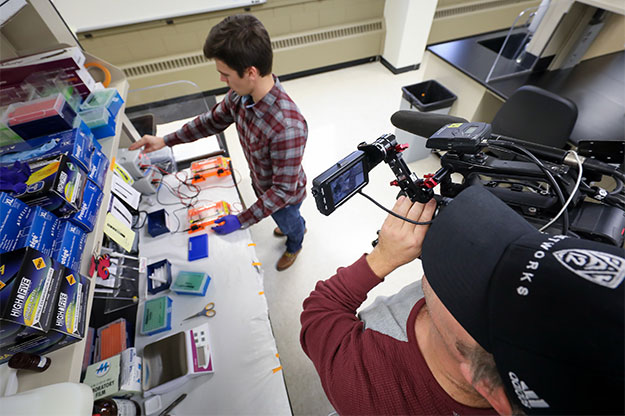Biology in focus
Documentary film crew visits UND to capture innovative climate-change research by grad students and faculty
The molecular biology lab of Starcher Hall was filled with a few more people than normal on Nov. 18 — and one more high-end video camera.
“My hand is shaky,” graduate student Sam Hervey said as a cameraman captured his intricate lab work.
A documentary crew from the New York- and Seattle-based Taking Flight Productions visited the University of North Dakota campus to film the data analysis of faculty and students involved in the “Hudson Bay Project.” The program is a nearly five-decade study of the climate and ecosystem changes on the western edge of Canada’s Hudson Bay. The research team, led by Dr. Robert Rockwell of the American Museum of Natural History, hopes to discover how climate change is impacting the wildlife, vegetation and overall ecology of the subarctic region.
UND Assistant Professor of Biology Susan Felege started her work with the project in 2014 when she was invited to add her waterfowl and camera technology expertise into the research equation. But this wouldn’t just be an individual endeavor.
“The Hudson Bay Project is very student-centric — trying to train the next generation of wildlife professionals,” Felege said. “That’s personally one of my major initiatives.”

Hands-on experience
This summer, Felege brought three UND biology graduate students with her — and briefly, one undergraduate — to contribute to the project and develop their own research areas.
“They’re the ones with the curiosity, the questions. They’re the ones that invigorate it,” Felege said.
Tanner Stechmann of Roseau, Minn., and Hervey of Grand Forks are both first-year graduate students in biology. This summer was Stechmann’s first time making the trip to Wapusk National Park near Hudson Bay. His research looks at the nesting patterns of a sea duck called the common eider. He uses trail cameras to capture the eiders’ day-to-day activities at the nesting site and document which predators the birds face at certain times of the season.
Hervey’s work looks at eiders as well, but also expands to snow geese. His goal is to use molecular data to find out if family members are nesting next to each other, and what that might mean for colony dynamics.
“I think collaboration is huge for all of our projects,” Stechmann said. “You kind of switch off doing each other’s work. We definitely need each other up there to be successful.”

Bird’s-eye view
British Columbia native Andrew Barnas is the third UND graduate student currently involved in the Hudson Bay Project. For the past couple of years, he has been working with unmanned aircraft systems (UAS), researching their use for ecological data collection.
“The first part of that has been evaluating behavioral responses of wildlife to unmanned aircraft surveys. Not a lot of work has been done on that,” Barnas said. “The second part is, now we have all sorts of fun images and data from (UAS) or drones, but how accurate is this? How representative is this compared to the data we have on the ground?”
The UND team’s use of camera technology — both on the ground and in the air — is an innovative aid to their research, but the outcome goes beyond data.
“The native people have a philosophy that they don’t want you to touch and disturb. You want to leave the least amount of imprint on the landscape when you’re doing this research,” Felege explained. “It’s allowing us to collect data differently than we could before and ask questions differently, and hopefully in a less invasive way.”
Lasting legacy
Much of UND’s Hudson Bay Project research is bird-based, but they also have opportunities to explore vegetation, soil ecology and more of the regional wildlife, including the area’s biggest tourist attraction.
“Experiencing the first polar bear, on the ground, in the field — that’s pretty exciting,” Stechmann explained as Hervey and Barnas nodded in agreement. “Once you realize you’re safe and you’ve done your homework, it’s a really cool experience.”
Beyond polar bears, expansive herds of caribou and breathtaking landscapes, there’s one thing that drives Barnas to return to the project summer after summer.
“There’s just so much history in this program,” he said. “Even in the physical buildings, there’s writing on the wall that’s 35 years old. You look at the list of past students and the scientists that this program has produced — that’s what’s kept me there.”
That history is what Taking Flight Productions is trying to preserve. The documentary team was one of five film crews that spent time this summer with the Hudson Bay Project, and they plan to return to film again in 2017.
“They know we have a job to get done at the same time, so they respect that aspect of it,” Hervey said of the documentary crew. “We’re not trying to make a shot for them; they’re trying to capture us.”
Production for the documentary, “A Bird’s Eye View,” will wrap in 2019 to be released in conjunction with the 50th anniversaries of the Hudson Bay Project and another research project featured: the Great Gull Island Project.


